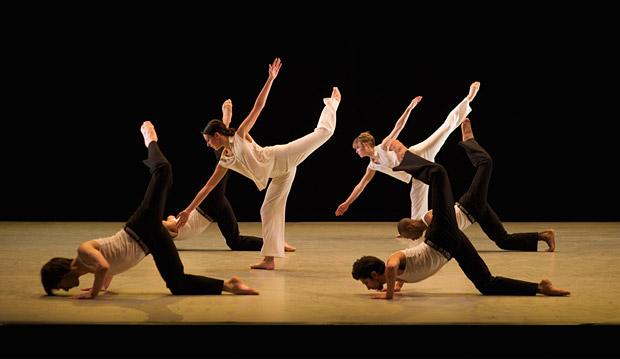
© Chris Nash. (Click image for larger version)
The Satisfactions of Structure
Richard Alston Dance Company
Roughcut, Unfinished Business, A Ceremony of Carols
New York, Alexander Kasser Theater
16 December 2012
Richard Alston website
www.peakperfs.org
Much contemporary dance seems to find its drive in an idea or a feeling – think of Nacho Duato or recent Forsythe – or from an exploration of movement, like the work of Crystal Pite or Wayne McGregor. But it’s remarkable how satisfying the old-fashioned virtues of structure and form can be. Richard Alston, whose company just completed a run at the Alexander Kasser Theatre at Montclair State University as part of the Peak Performance series, is a master builder; he creates islands of order in a chaotic world. (He’s not alone in this, of course, but it is an increasingly rare breed.) Alston is not reinventing the wheel or re-shaping our idea of what the body can do. Even more than Mark Morris or Paul Taylor, he uses and re-uses recognizable steps, many of which can be traced back to a simplified, de-historicized balletic vocabulary. And, unlike his early days as a modern-dance pioneer when he set dances to clicks and clangs, Alston tends to use “serious,” well-structured music. His choreography closely reflects the architecture of the music, often repeating phrases when the music repeats, or adding new dancers when a new voice enters the musical tapestry.

© Tony Nandi. (Click image for larger version)
The Sussex-born Alston trained in modern dance and ballet at the London Contemporary Dance School in the late sixties; later, he became so fascinated by the formalist style of Merce Cunningham that he came to New York in 1975 to study at the Cunningham studio. The Cunningham influence is recognizable in the highly technical quality of the steps, the articulate use of the feet, the fullness of movement in the torso, the tilts and balances, and the objectivity of the movement. The dancers relate to each other as people, as collaborators in a common effort, but seldom as participants in a drama. The influence of Paul Taylor also seems clear; I see it in the way the dancers walk (or jog) casually on and offstage and move their arms in “plain,” vigorously open positions, and in the way the impetus for movement often initiates from the back. As with Taylor, too, the choreography is amazingly dynamic. Alston’s dancers eat up space and never seem to tire. But Alston’s dancers are remarkably human in their proportions; they lack the larger-than-life, heroic quality of the Cunningham and Taylor troupes. They tend to be compact, sunny but not ingratiating, grounded but buoyant. The men stand out more than the women, in part because of the emphasis on jumps. (The choreography is strikingly egalitarian, with the women supporting the men almost as often as the opposite and lyricism equally distributed between the two sexes.)

© Chris Nash. (Click image for larger version)
The program consisted of three dances. Roughcut, from 1990, is a pleasingly formal composition set to two recorded Steve Reich scores, one for woodwinds and the other for guitar. Alston listens extremely closely to the music; in the slow movement, a squiggle for the clarinet becomes a squiggle for a dancer’s hand. A jazzy section is reflected in a kind of deconstructed Charleston step. The distribution of dancers on the stage is constantly shifting: a trio becomes a duet, only to multiply suddenly into a quintet. The texture is similarly varied, with unison reshuffling into canon, or counterpoint, or a contrasting conversation between fast and slow tempi. Everything fits together and the eye is constantly engaged. Pierre Tappon, in particular, stands out for his endless reserves of energy and relaxed focus. Roughcut is a lovely piece, if perhaps a tad relentless.
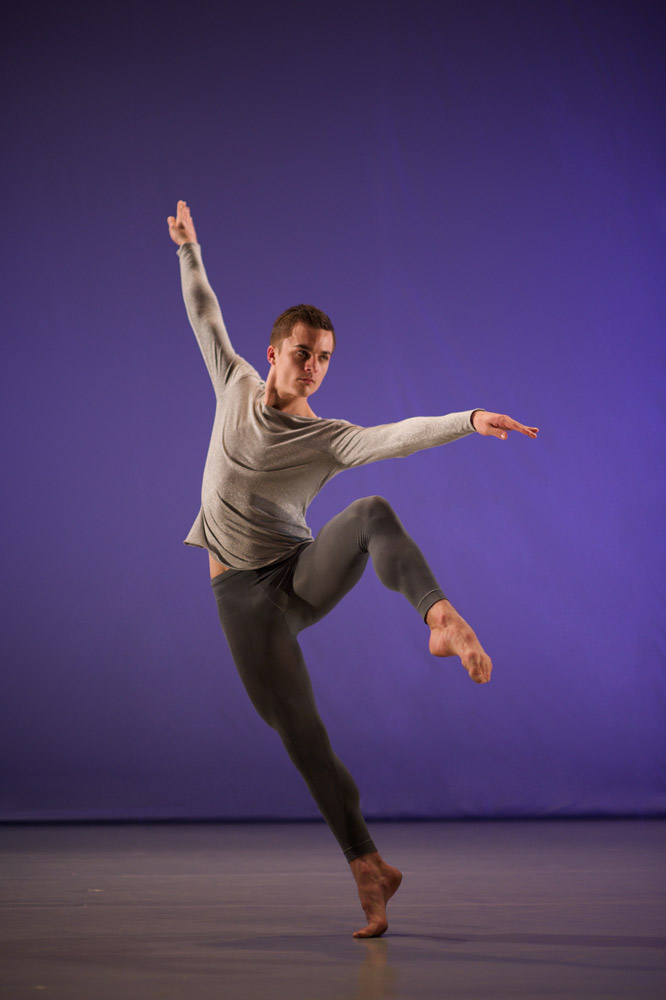
© Chris Nash. (Click image for larger version)
Unfinished Business (2011), which followed, is quieter, more poetic. The first section, set to the opening movement of a Mozart piano sonata (No. 15) is built around a meditation for a boy in gray (the very lyrical Liam Riddick). As it begins, he faces the piano at the rear of the stage, eloquently played by Jason Ridgway. His phrases hew closely to Mozart’s, down to small details; a repeated two-note figure is reflected in a rocking motion which returns again and again. Other dancers come and go, but with each reoccurrence of the opening melody Riddick reappears, repeating and modulating his original steps. The second, slow movement opens up to a sorrowful pas de deux. A woman (Elly Braund) lunges forward, face down; her partner (James Pett) turns slowly with one leg extended, passing just above the woman’s head. She lies down and presses herself into a ball; he puts a hand on her shoulder. The duet is a rare expression of possible hidden meanings. In its intimate feel, Unfinished Business reminded me of Alexei Ratmansky’s all-white ballet, Seven Sonatas, set to Scarlatti keyboard pieces. But unlike Ratmansky Alston resists developing overarching themes and allows for less differentiation between the dancers. Their individual qualities remain elusive, as if shielded behind a scrim of formality.
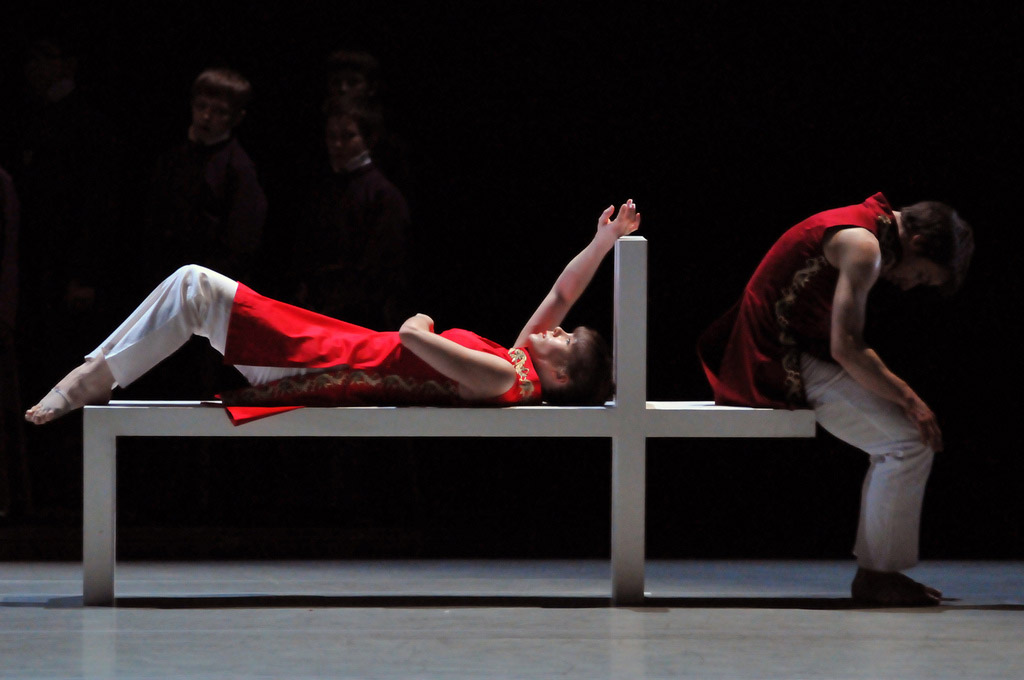
© Dave Morgan. (Click image for larger version)
The program ended with a première (for US audiences) of a new ballet set to Benjamin Britten’s transcendently lovely Ceremony of Carols. Here again the music (for harp and chorus) was performed live. The harpist, André Tarnatiles, brought out sharply contrasting textures; his pianissimi were softer than a whisper, almost like the ghost of a sound. The all-female chorus, Prima Voce, sang with touching limpidness of tone and great feeling. Here, Alston’s inspiration faltered; perhaps there is simply no match for Britten’s haunting harmonies. The music’s dappled surface, like silvery pools of light, was distractingly beautiful; some music is simply too redolent with aural images to be easily coupled with dancing. I was tempted at times to close my eyes and give myself completely to the sound. In a way, Alston’s choreography acknowledged this; for the most part, it seemed to be trying not to get in the way, relying on simple patterns, lines of dancers walking forward or forming tidal whirlpools. There was a hint of stylized gesture, such as a hand covering the eyes. A duet suggested the tragic fate of Christ, his crucifixion and Mary’s grief; a white bench at the rear of the stage became the cross. The image was surprisingly subtle, and all the more moving. The finale yielded, once again, to the power of the music; the dancers kneeled, then lowered themselves to the grand, face-down, an image of prostration and loss. There was nothing left to say.













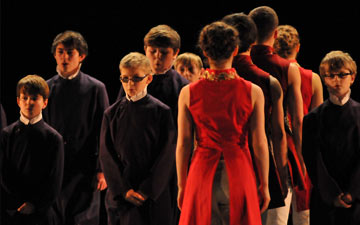
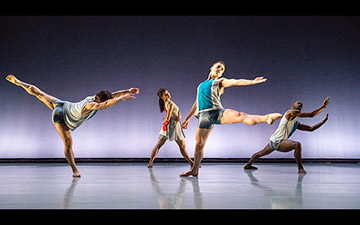


You must be logged in to post a comment.